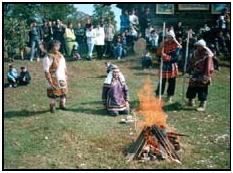Primorsky Krai Regional Authorities trying to undermine protected tiger habitat
Conservationists fighting to prevent liquidation of Verkhnebikinski Wildlife Refuge, against pressure from logging and mining interests
Document created 10 May 2006, last updated 11 May 2006

The Bikin River valley itself is considered as a potential World Heritage site thanks to a combination of outstanding natural and human heritage values:
- presence of the largest remaining massif of natural cedar-broad-leafed forest,
- habitat and a reproductive centre for the northeast group of Amur Tigers, a population estimated at 30 to 50 individuals, and perhaps one-sixth of the total Amur tigers in the wild,
- important habitat for a range of species including wild boar, Asiatic black bear, Brown bear, sable, Siberian weasel, squirrel, badger, lynx, mink, hare, otter, Siberian stag, hazel grouse, wood grouse and storks on the lower Bikin,
- one of the last preserved living areas of a group of small far-eastern indigenous peoples such as the Udege.

The protected area includes a previously created “territory of traditional land use” (TTLU) of approximately 408 000 ha (1,020,000 acres) where no development can take place without the consent of the local Udege people. Elsewhere the status established in 1993 remains in place, whereby the exploitation of primary forest is allowed, but limited.
The refuge was soon under attack, however, as in 2003 Primorye forest products companies approached the regional administration seeking a reduction of the protected area and permission to log unoccupied areas. Since then the administration has been trying to liquidate the refuge, so far unsuccessfully in the face of conservationists’ involvement, especially its own Main Directorate for Natural Resources and Environmental Protection (GUPR).
One of the reported methods used by the regional administration to this end was to stop funding the refuge (its budgetary responsibility), then to argue that no conservation was taking place, justifying the reserve’s liquidation.
In the face of such difficulties from 2004 GUPR was able to obtain external funding (notably from 21st Century Tiger and the Phoenix Fund, cf. links provided) and put in place a project for Amur tiger habitat protection and population survival in the North of Primorsky region, which includes:
- protection of tiger habitat through land patrolling and anti-poaching action,
- seeking to gain support and involvement of the local population in the conservation work.
Another series of threats to the refuge arose in 2005 with the passing of a new decree allowing exploration work and mining, house and road building and research work in Verkhnebikinsky wildlife refuge. However the legal procedure for such legislation had not been properly followed, as no preliminary environmental assessment had been conducted. This allowed the Primorsky Environmental Prosecutor, upon seizure by Primorsky Department of Federal Nature Use Service and local NGOs, to bring action against the Governor’s decision and on November 15, 2005 the decree was declared invalid. In turn the Primorsky krai administration appealed, and as reported in February 2006 the case is still pending.
This article is based on two reports from the Phoenix Fund regarding Amur/Siberian Tiger Conservation in Verkhnebikinski Widlife Refuge: refer to links provided (right column in this page). Visit 21st Century Tiger website to support their action (link provided).
Links to external websites:
[wb1] Phoenix Fund report 2004-2005 - Report's full text online (PDF 1.46 Mb)
[wb2] Phoenix Fund report 2005-2006 - Report's full text online (PDF 442 Kb)
[wb3] 21st Century Tiger - 21st Century Tiger is a unique wild tiger conservation partnership between the Zoological Society of London and Global Tiger Patrol.
Comments
No comment available for this document


